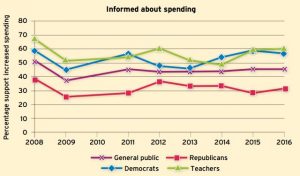Public Woefully Misunderstands Education Spending, Study Finds
The U.S. public “seriously underestimates” how much money is spent on education, and has done so consistently over the years, according to an annual study released today by Education Next, a scholarly journal.
The pattern of public misunderstanding about school expenditures has held steady across the decade, according to the study conducted by the journal, which is published by the Hoover Institution at Stanford University and the Harvard Program on Education Policy and Governance at the Harvard Kennedy School.
While most respondents to the survey favor higher levels of per-pupil spending, the study found that “people seriously underestimate both school expenditures and teacher pay,” the authors wrote. Once respondents were informed about current expenditure levels, support for increased levels of spending was 45 percent in 2016. (See the chart about the percentage of support for increased spending, once respondents were informed about the actual spending in their district.)

When respondents were asked to estimate per-pupil spending in their local school district, the average response in 2016 was $7,020, according to the report. That’s just over 50 percent of the actual average, which is $12,440, researchers found.
“That underestimation may color people’s thinking as to whether or not expenditures should go up,” the authors wrote.
Since 2007, the researchers have found that survey respondents want to spend less when they are informed about current expenditure levels.
“We weren’t surprised to see that finding again this year,” said Martin R. West, editor-in-chief of Education Next, in a call about the report. “And we don’t have a definitive explanation for why … systematic underestimation” persists. When people are provided the actual numbers, it “dampens” the interest some of them have in increasing expenditures, he said.
One issue is that it’s hard to find timely and accurate information about the level of spending on education that combines local, state and federal resources. That information is ultimately published by the Department of Education, but several years after the fact.
The most recent statistics used for the 2016 survey come from the National Center for Education Statistics’ report on the 2011-12 school year, for instance.
The study was based on a nationally representative poll of 4,181 adults, including 609 teachers and 1,571 parents with school-aged children living in their homes.
The full report is available here, and interactive charts can be found here.
See also:
